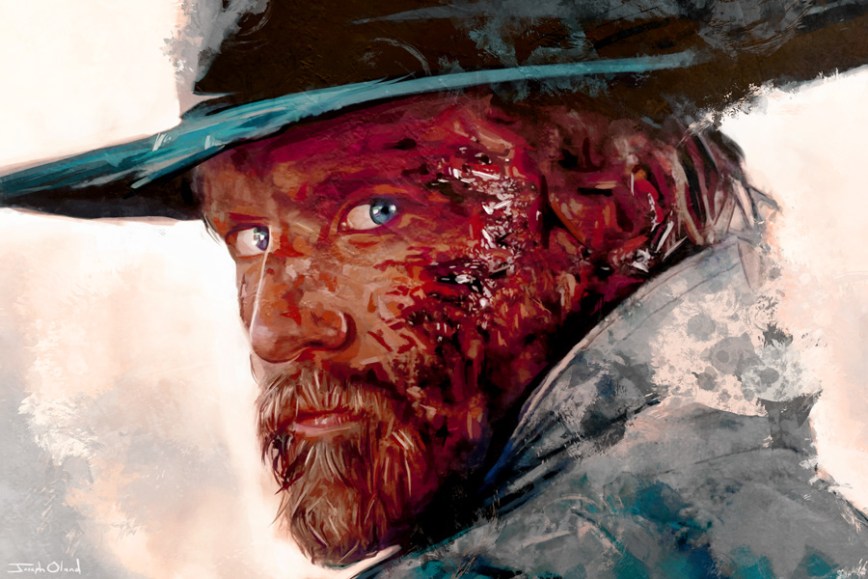
FINE ART PRINTS AVAILABLE HERE
– – –
ALL ‘SAUL’ & ‘BREAKING BAD’ MERCHANDISE HERE
Jimmy: Does that look straight to you?
Francesca: I think you’re a little crooked.
Jimmy: Yeah…a little crooked…
This is precisely the kind of nuanced conversation that Better Call Saul fans love. Of course we know that these two characters aren’t discussing the moral turpitude of the show’s ethically challenged protagonist – they’re discussing the paint job in the lobby of Jimmy’s new law practice. We’re all in on the joke, though, and the actors play it totally straight, which perfectly sells the moment.
The scene involves Jimmy McGill (Bob Odenkirk) meeting Francesca Liddy (Tina Parker) for the first time. A former Motor Vehicle Division employee, she’s looking to apply as a receptionist for the Law Offices of Wexler-McGill. This is yet another introduction of a Breaking Bad alum, a tertiary character embedded in the narrative for longtime fans to appreciate and for newcomers to meet for the first time.
That’s the subtle magic of Better Call Saul. Seeing Tuco Salemanca in season one was a great reveal, inciting audiences to question precisely how the floundering public defendant, Jimmy McGill, eventually manages to ingratiate himself among the prolific criminal empires we already know about from Breaking Bad. In season two we have the one-two punch of seeing ‘The Cousins’ as well as the drug kingpin himself, Hector Salemanca. Rumors of Walter White (Bryan Cranston) making a cameo – even just a simple glimpse of him walking through the background of a scene – have been circulating on social media for over a year, and the anticipation of Gus Fring’s (Giancarlo Esposito) return in season three has had fans wringing their fingers for months.
It’s a tricky narrative dance, introducing an ensemble of characters that audiences are already familiar with and whose ultimate fates are already known. Breaking Bad aficionados already know exactly what happens to Tuco, Hector, The Cousins, Gus, and many, many others. How does the show motivate interest when it’s already known what happens further down the line? The prequel game is a tricky one, but somehow it has been working for Vince Gilligan and Co, who have managed to keep audiences engaged.
The other interesting aspect of Better Call Saul in general, and season three in specific, is the minimalist approach to dialogue. Some people may find the pacing too slow, especially compared to Breaking Bad, with long sequences in which characters are thinking, plotting, planning, studying, or hunting. ‘No dialogue’ means one serious thing: you have to keep your eyes on the screen and you have to pay attention.
Visual story-telling has made a huge resurgence, both in television and film, and Better Call Saul has been expert in maintaining narrative intrigue with a minimal approach to dialogue – especially in a number of Mike Ehrmantraut (Jonathan Banks) scenes. This week’s scene in Los Pollos Hermanos when Jimmy is sitting in his booth, not a word is spoken. Jimmy sits, fumbles with his food, and waits for his mark to arrive. Then we watch Jimmy struggle to figure out how to get close to his mark, eavesdrop, and find a new seat close enough to keep the man in his sight-line. I’m reminded of the massive success of ‘Mad Max: Fury Road’ and the fact that the entire film could have been silent (and there genuinely was very little dialogue) and audiences would have completely understood the universe that these characters inhabit. I’m also reminded of ‘No Country For Old Men,’ where entire scenes unfold in silence, motivating viewers to put themselves in the mind of the protagonist and guess at what he’s thinking and wondering the exact same things he must be wondering. It’s a brilliant device that rewards patience.
– – –
No breakdowns here. If you’re reading this you’ve seen the episode. Ehrmantraut is slowly unraveling details about the Salemanca Cartel’s rivalry with Gus Fring’s operation, even though he has yet to identify Gus Fring as a major player. He knows he’s being tracked, and he’s using his exceptional skill and patience to solve the problem. Chuck has successfully sabotaged his brother Jimmy, and Kimmy is going to be stuck in the middle of this colossal lie-laden disaster. How much does Fring actually know, and what are his plans? That’ll have to be left for later episodes, it seems.
At the end of the day, this writer has one humble prediction for the show: most of the characters who aren’t in Breaking Bad – Chuck McGill, Kim Wexler, Nacho Varga – aren’t going to escape Better Call Saul with their lives. Losing Chuck and Kim would be a logical conclusion to Jimmy’s unique Faustian tale. The obliteration of family and love, a corrupt and ugly dance with the devil, will lead to Jimmy’s metamorphosis into the morally bankrupt Saul Goodman we met in Breaking Bad.
I’d be willing to put money on it.
– – –
Afterthoughts: there’s a fun little easter egg that seems to have gone under a lot of people’s radar.
The cigarette smoking driver that sped away from Los Pollos Hermanos in order to lure Mike onto a remote stretch of desert highway? That’s right, it’s Victor, Fring’s perpetually scowling henchman tasked with guarding Walter White and Jesse Pinkman in the underground lab. If this isn’t ringing a bell, just think “Gus Fring – Utility Knife.”
No dialogue means one thing: pay attention.
READ LAST WEEK’S REVIEW
– – –
SIGN UP FOR THE LENSEBENDER NEWSLETTER
 MERCHANDISE AND ORIGINAL CANVAS AVAILABLE HERE
MERCHANDISE AND ORIGINAL CANVAS AVAILABLE HERE
 FINE ART PRINTS AVAILABLE HERE
FINE ART PRINTS AVAILABLE HERE FINE ART PRINTS AVAILABLE HERE
FINE ART PRINTS AVAILABLE HERE